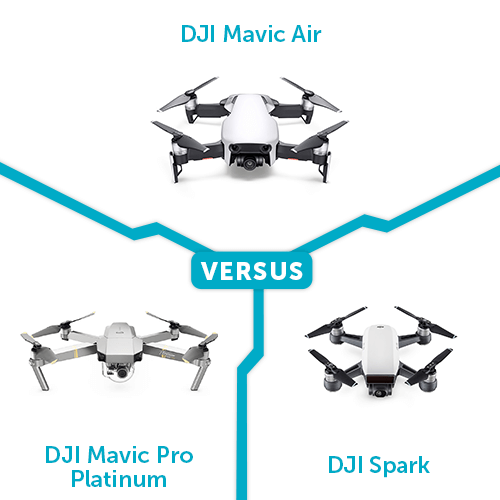
Products
DJI Mavic Air Vs Mavic Pro Vs Spark
With DJI's announcement of the new Mavic Air, Heliguy Insider are doing their standard versus post to see how it compares to the DJI Mavic Pro and DJI Spark. ... Read More
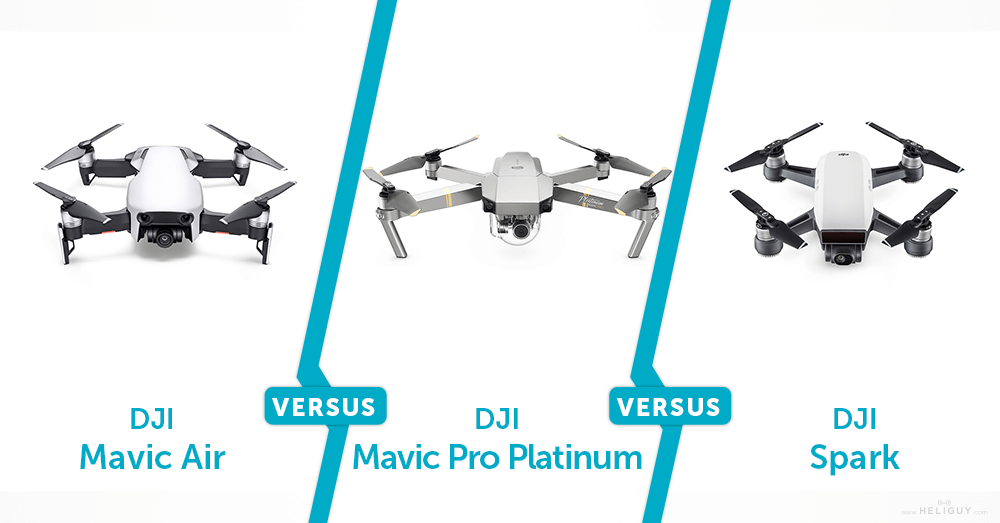
.embed-container { position: relative; padding-bottom: 56.25%; height: 0; overflow: hidden; max-width: 100%; } .embed-container iframe, .embed-container object, .embed-container embed { position: absolute; top: 0; left: 0; width: 100%; height: 100%; }
Specifications
As with all our versus post, let's start by taking a look at the specifications of each of the aircraft:
1516732016Mavic_Air-small.png DJI Mavic Air | 1516731972Mavic_Pro_Platinum-small.png DJI Mavic Pro Platinum | 1495632313DJI_Spark-Small.png DJI Spark |
#### Dimensions | Folded: 168 x 83 x 49 mm (LxWxH) Unfolded: 168 x 184 x 64 mm (LxWxH) | Folded: 83 x 83 x 198 mm | 143 x 143 x 55 mm |
#### Diagonal Distance | 213 mm | 335 mm (Propellers Excluded) | 170 mm (Propellers Excluded) |
#### Weight | 430 g (Takeoff Weight) | Battery & Propellers Included: 734 g (exclude gimbal cover) 743 g (include gimbal cover) | 300 g (Takeoff Weight) |
#### Max Ascent Speed | 3 m/s (S - mode) 2 m/s (P - mode) 2 m/s (Wi-Fi mode) | 5 m/s (Sport mode) | 3 m/s (Sport Mode without wind) |
#### Max Descent Speed | 2 m/s (S - mode) 1.5 m/s (P - mode) 1 m/s (Wi-Fi mode) | 3 m/s | 3 m/s (Auto Landing Mode) |
#### Max Speed | Near sea level, no wind 68.4 kph (S - mode) 28.8 kph (P - mode) 28.8 kph (Wi-Fi mode) | 40 mph (65 kph) in Sport mode without wind | 31 mph (50 kph) in Sport Mode without wind |
#### Max Service Ceiling Above Sea Level | 5000 m | 5000 m | 4000 m |
#### Max Flight Time | 21 minutes (at a consistent 25 kph, no wind) | 30 minutes (at a consistent 25 kph, no wind) | 16 minutes (at a consistent 20 kph, no wind) |
#### Max Hovering Time | 20 minutes (no wind) | 27 minutes (no wind) | 15 minutes (no wind) |
#### Max Flight Distance | 10 km (at a consistent 25 kph, no wind) | 15 km (one full battery, no wind) | N/A |
#### Max Tilt Angle | 35° (S - mode); 25° (P - mode) | N/A | N/A |
#### Max Angular Velocity | 250°/s (S - mode); 250°/s (P - mode) | N/A | N/A |
#### Operating Frequency | 2.400 - 2.4835 GHz 5.725 - 5.850 GHz | FCC: 2.4 - 2.4835 GHz; 5.150 - 5.250 GHz; 5.725 - 5.850 GHz CE: 2.4 - 2.4835 GHz; 5.725 - 5.850 GHz SRRC: 2.4 - 2.4835 GHz; 5.725 - 5.850 GHz | 2.400 - 2.483 GHz; 5.725 - 5.825 GHz |
#### Transmission Power (EIRP) | 2.400 - 2.4835 GHz FCC: ≤28 dBm; CE: ≤19 dBm; SRRC: ≤19 dBm; MIC: ≤19 dBm 5.725 - 5.850 GHz FCC: ≤31 dBm; CE: ≤14 dBm; SRRC: ≤27 dBm | 2.4GHz FCC: <=26 dBm; CE: <=20 dBm; SRRC: <=20 dBm; MIC: <=18 dBm 5.2 GHz FCC: <=23 dBm 5.8 GHz FCC: <=23 dBm; CE <=13 dBm; SRRC: <=23 dBm; MIC: - | 2.4 GHz FCC: 25 dBm; CE: 18 dBm; SRRC: 18 dBm; MIC:18 dBm 5.8 GHz FCC: 27 dBm; CE: 14 dBm; SRRC: 27 dBm; MIC: - |
#### Satellite Positioning Systems | GPS + GLONASS | GPS / GLONASS | GPS/GLONASS |
#### Hover Accuracy Range | Vertical: ±0.1 m (with Vision Positioning); ±0.5 m (with GPS Positioning) Horizontal: ±0.1 m (with Vision Positioning); ±1.5 m (with GPS Positioning) | Vertical: ±0.1 m (when Vision Positioning is active) or ±0.5 m Horizontal: ±0.3 m (when Vision Positioning is active) or ±1.5 m | Vertical: ±0.1 m (when Vision Positioning is active) or ±0.5 m Horizontal: ±0.3 m (when Vision Positioning is active) or ±1.5 m |
#### Internal Storage | 8 GB | N/A | N/A |
Gimbal
#### Stabilization | 3-axis (tilt, roll, pan) | 3-axis (pitch, roll, yaw) | 2-axis mechanical (pitch, roll) |
#### Controllable Range | Tilt: -90° to 0° (default setting); -90° to +17° (extended) | Pitch: -90° to +30°; Roll: 0° or 90° (Horizontally and vertically) | Pitch: -85° to 0° |
#### Mechanical Range | Tilt: -100° to 22°; Roll: -30° to 30°; Pan: -12° to 12° | N/A | N/A |
#### Max Control Speed (tilt) | 120°/s | N/A | N/A |
#### Angular Vibration Range | ±0.005° | N/A | N/A |
Camera
#### Sensor | 1/2.3" CMOS; Effective Pixels: 12 MP | 1/2.3" CMOS; Effective Pixels: 12.35 MP (Total Pixels: 12.71 MP) | 1/2.3" CMOS; Effective Pixels: 12 MP |
#### Lens | FOV: 85°; 24 mm (35 mm format equivalent); Aperture: f/2.8; Shooting Range: 0.5 m to ∞ | FOV: 78.8°; 28 mm (35 mm format equivalent); f/2.2; Distortion < 1.5% Focus from 0.5 m to ∞ | FOV: 81.9°; 25 mm (35 mm format equivalent); f/2.6 (shooting range: 2 m to ∞) |
#### ISO Range | Video: 100 - 1600 (auto); 100 - 1600 (manual) Photo: 100 - 1600 (auto); 100 - 3200 (manual) | Video: 100 - 3200; Photo: 100 - 1600 | Video: 100 - 3200; Photo: 100 - 1600 |
#### Electronic Shutter Speed | 8 - 1/8000s | 8 -1/8000s | 2 - 1/8000s |
#### Image Size | 4:3: 4056 x 3040; 16:9: 4056 x 2280 | 4000 x 3000 | 3968 x 2976; 1440 x 1080 with ShallowFocus; 2300 x 1280 with Pano (horizontal); 960 x 1280 with Pano (vertical) |
#### Still Photography Modes | Single shot; HDR; Burst shooting: 3 / 5 / 7 frames; Auto Exposure Bracketing (AEB): 3/5 bracketed frames at 0.7EV Bias; Interval: 2 / 3 / 5 / 7 / 10 / 15 / 20 / 30 / 60 s | Single shot; Burst shooting: 3 / 5 / 7 frames; Auto Exposure Bracketing (AEB): 3/5 bracketed frames at 0.7 EV Bias Interval | Single Shot; Burst Shooting: 3 frames; Auto Exposure Bracketing (AEB): 3 bracketed frames at 0.7 EV bias; Interval: 2 / 3 / 5 / 7 / 10 / 15 / 20 / 30 / 60 s |
#### Video Resolution | 4K Ultra HD: 3840 x 2160 24 / 25 / 30p; 2.7K: 2720 x 1530 24 / 25 / 30 / 48 / 50 / 60p; FHD: 1920 x 1080 24 / 25 / 30 / 48 / 50 / 60 / 120p; HD: 1280 x 720 24 / 25 / 30 / 48 / 50 / 60 / 120p | C4K: 4096 x 2160 24p; 4K: 3840 x 2160 24 / 25 / 30p; 2.7K: 2720 x 1530 24 / 25 / 30p; FHD: 1920 x 1080 24 / 25 / 30 / 48 / 50 / 60 / 96p; HD: 1280 x 720 24 / 25 / 30 / 48 / 50 / 60 / 120p | FHD: 1920 x 1080 30p |
#### Max Video Bitrate | 100 Mbps | 60 Mbps | 24 Mbps |
#### Supported File System | FAT32 | FAT32 ( ≤ 32 GB ); exFAT ( > 32 GB ) | FAT32 |
#### Photo Format | JPEG / DNG (RAW) | JPEG, DNG | JPEG |
#### Video Format | MP4 / MOV (H.264 / MPEG-4 AVC) | MP4, MOV (MPEG-4 AVC / H.264) | MP4 (MPEG-4 AVC / H.264) |
Vision System
#### Vision System | Forward Vision System; Downward Vision System; Backward Vision System | Forward Vision System; Downward Vision System | Forward Vision System |
#### Operating Range | 0.5 - 30 m (Downward) | 0.3 - 13 m | 0 - 30 m |
#### Altitude Range | 0.1 - 8 m (Downward) | 0.3 - 13 m | 0 - 8 m |
#### Velocity Range | ≤ 8 m/s (Backward and Forward) | ≤22.4 mph (36 kph) at 6.6 ft (2 m) above ground | ≤22.4 mph (36 kph) at 6.6 ft (2 m) above ground |
Intelligent Flight Battery
#### Capacity | 2375 mAh | 3830 mAh | 1480 mAh |
#### Voltage | 11.55 V | 11.4 V | 11.4 V |
#### Battery Type | LiCoO2 3S | LiPo 3S | LiPo 3S |
#### Energy | 27.43 Wh | 43.6 Wh | 16.87 Wh |
#### Net Weight | 140 g | Approx. 240 g | Approx. 95 g |
Remote Controller
#### Operating Frequency | 2.400 - 2.4835 GHz; 5.725 - 5.850 GHz | 2.4 GHz to 2.483 GHz | 2.412 - 2.462 GHz; 5.745 - 5.825 GHz |
#### Max Transmission Distance (unobstructed, free of interference) | 2.400 - 2.4835 GHz: FCC: 4000 m; CE: 2000 m; SRRC: 2000 m; MIC: 2000 m 5.725 - 5.850 GHz: FCC: 4000 m; CE: 500 m; SRRC: 2500 m | FCC Compliant: 4.3 mi (7 km); CE Compliant: 2.5 mi (4 km); SRRC Compliant: 2.5mi (4 km); MIC Compliant: 2.5 mi (4 km) | 2.412 - 2.462 GHz: FCC: 1.2 mi (2 km); CE: 0.3 mi (500 m); SRRC: 0.3 mi (500 m); MIC: 0.3 mi (500 m) 5.745 - 5.825 GHz: FCC: 1.2 mi (2 km); CE: 0.18 mi (300 m); SRRC: 0.7 mi (1.2 km); MIC: - |
#### Transmission Power (EIRP) | 2.400 - 2.4835 GHz: FCC:≤26 dBm; CE: ≤18 dBm; SRRC: ≤18 dBm; MIC:≤18 dBm 5.725 - 5.850 GHz: FCC: ≤30 dBm; CE: ≤14 dBm; SRRC: ≤26 dBm | FCC: <=26 dBm; CE: <=20 dBm; SRRC: <=20 dBm; MIC: <=18 dBm | 2.4 GHz: FCC: ≤26 dBm; CE: ≤18 dBm; SRCC: ≤18 dBm; MIC: ≤18 dBm 5.8 GHz: FCC: ≤28 dBm; CE: ≤14 dBm; SRCC: ≤26 dBm; MIC: - |
#### Battery | 2970 mAh | 2970mAh | 2970 mAh |
#### Operating Current / Voltage | 1400 mA @ 3.7 V (Android); 750 mA @ 3.7 V (iOS) | 950 mA @ 3.7 V | 950 mA @ 3.7 V |
#### Supported Mobile Device Size | Max length: 160 mm; Supported Thickness: 6.5 - 8.5 mm | Max length: 160 mm; Supported Thickness: 6.5 - 8.5 mm | Max length: 160 mm; Supported Thickness: 6.5 - 8.5 mm |
#### Supported USB Port Types | Lightning, Micro USB (Type-B), USB-C | Lightning, Micro USB (Type-B), USB (Type-C) | N/A |
As you can see, there are some similarities between the Mavic Air, Mavic Pro and the Spark in their specifications. Keep reading to find out more information about each of these impressive aircraft and see which is the best aircraft for you.
What's Included?
The DJI Mavic Air, Mavic Pro and Spark are all available in either a standard package or Fly More Combo which comes with additional accessories.
1516732016Mavic_Air-small.png DJI Mavic Air | Mavic Air * Aircraft * Remote Controller * Intelligent Flight Battery x1 * Charger * Power Cable * Propellers (Pair) x4 * Propeller Guards (Set) * RC Cable (Lightning connector) * RC Cable (Standard Micro USB connector) * RC Cable (USB Type-C connector) * Gimbal Protector * Communication Cable (USB 3.0 Type C) * USB Adapter * RC Cable Slider (Large) * RC Cable Slider (Small) * Carrying Case * Spare Control Sticks (Pair) | Mavic Air Fly More Combo * Aircraft * Remote Controller * Intelligent Flight Battery x3 * Charger * Power Cable * Propellers (Pair) x6 * Propeller Guards (Set) * RC Cable (Lightning connector) * RC Cable (Standard Micro USB connector) * RC Cable (USB Type-C connector) * Gimbal Protector * Communication Cable (USB 3.0 Type C) * USB Adapter * RC Cable Slider (Large) * RC Cable Slider (Small) * Carrying Case * Spare Control Sticks (Pair) * Battery Charging Hub * Battery to Power Bank Adaptor * Travel Bag |
Mavic Pro Platinum * Aircraft * Remote Controller * Intelligent Flight Battery x1 * Charger * Power Cable * Gold Tip Propellers (Pair) * Platinum Tip Propellers (Pair) x2 * RC Cable (Lightning connector) * RC Cable (Standard Micro USB connector) * RC Cable (USB Type-C connector) * Gimbal Cover * Gimbal Clamp * MicroSD Card (16GB) * Micro USB Cable * RC Cable Slider (Large) * RC Cable Slider (Small) | Mavic Pro Platinum Fly More Combo * Aircraft * Remote Controller * Intelligent Flight Battery x1 * Charger * Power Cable * Gold Tip Propellers (Pair) * Platinum Tip Propellers (Pair) x3 * RC Cable (Lightning connector) * RC Cable (Standard Micro USB connector) * RC Cable (USB Type-C connector) * Gimbal Cover * Gimbal Clamp * MicroSD Card (16GB) * Micro USB Cable * RC Cable Slider (Large) * RC Cable Slider (Small) * Battery Charging Hub * Car Charger * Battery to Power Bank Adaptor * Shoulder Bag | 1516731972Mavic_Pro_Platinum-small.png DJI Mavic Pro Platinum |
1495632313DJI_Spark-Small.png DJI Spark | Spark * Aircraft * Propeller Pair * Intelligent Flight Battery x1 * Charger * Micro USB Cable * Storage Box | Spark Fly More Combo * Aircraft * Remote Controller * Propeller Pair * Propeller Guards (Pair) * Intelligent Flight Battery x2 * Charger * Power Cable * Battery Charging Hub * Micro USB Cable * Storage Box * Shoulder Bag |
The most noteworthy areas from what’s included are; like the Mavic Pro, each package of the Mavic Air comes with a remote controller whereas this is only included in the Spar’s Fly More Combo. Also, both the Mavic Air packages include propeller guards for increased safety during hand launching or flight in tight spaces. This is a great addition as they’re not available in either of the Mavic Pro packages and only in the Spark Fly More.
Appearance
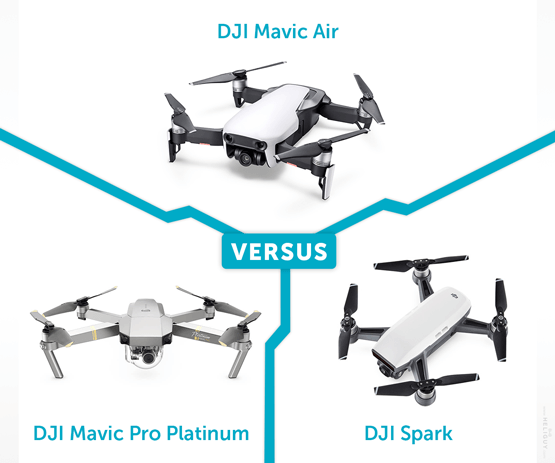
Performance
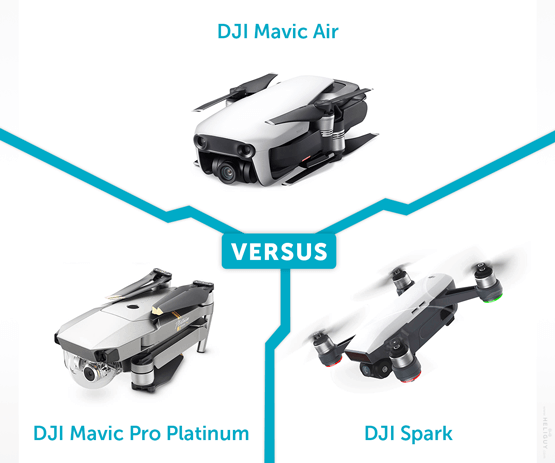
Camera
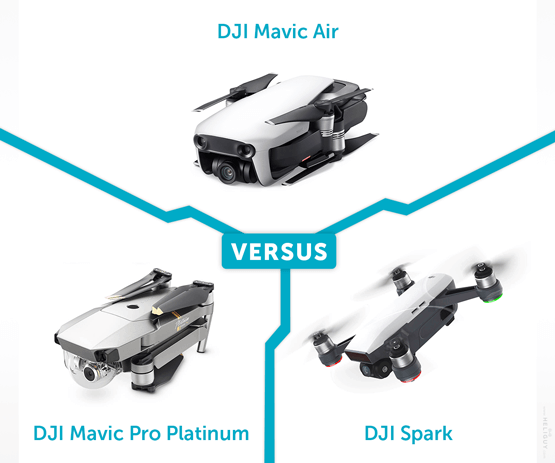
Battery
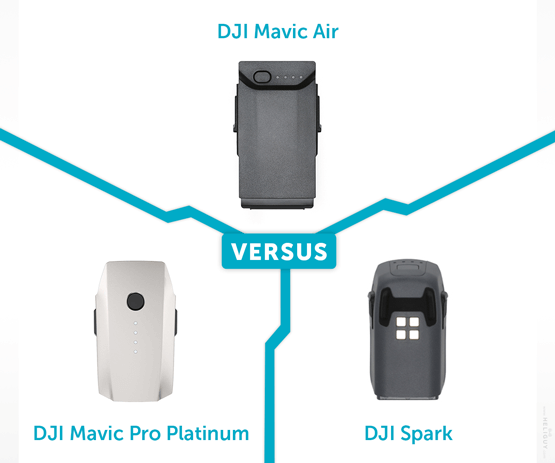
Summary
The new DJI Mavic Air is a superb aircraft from DJI. DJI have taken the iconic foldable design from the Mavic Pro and smart feature from the Spark and made their most transportable drone to date. It's highly functional and can help you capture some amazing videos and images whilst keeping the aircraft safe. The Mavic Pro clearly stands out due to its battery life and modes such as Tripod mode and the Spark will always be a top performer with its hand launch and landing. Overall, you will be happy with any of the above drones dependent on what you want it for, but we're really excited to get the new Mavic Air out and test out these new impressive functions. The Mavic Air is expected to be delivered early February, so pre-order yours now to ensure you get it first.
To discuss the new DJI Mavic Air or any DJI or Freefly product, please give one of our team a call on 0191 296 1024 or email us at info@heliguy.com.
Keep checking back to Heliguy’s Insider Blog to learn more about DJI’s latest products, read our in-depth VERSUS series and, of course, stay up to date on the goings-on in the drone industry.
